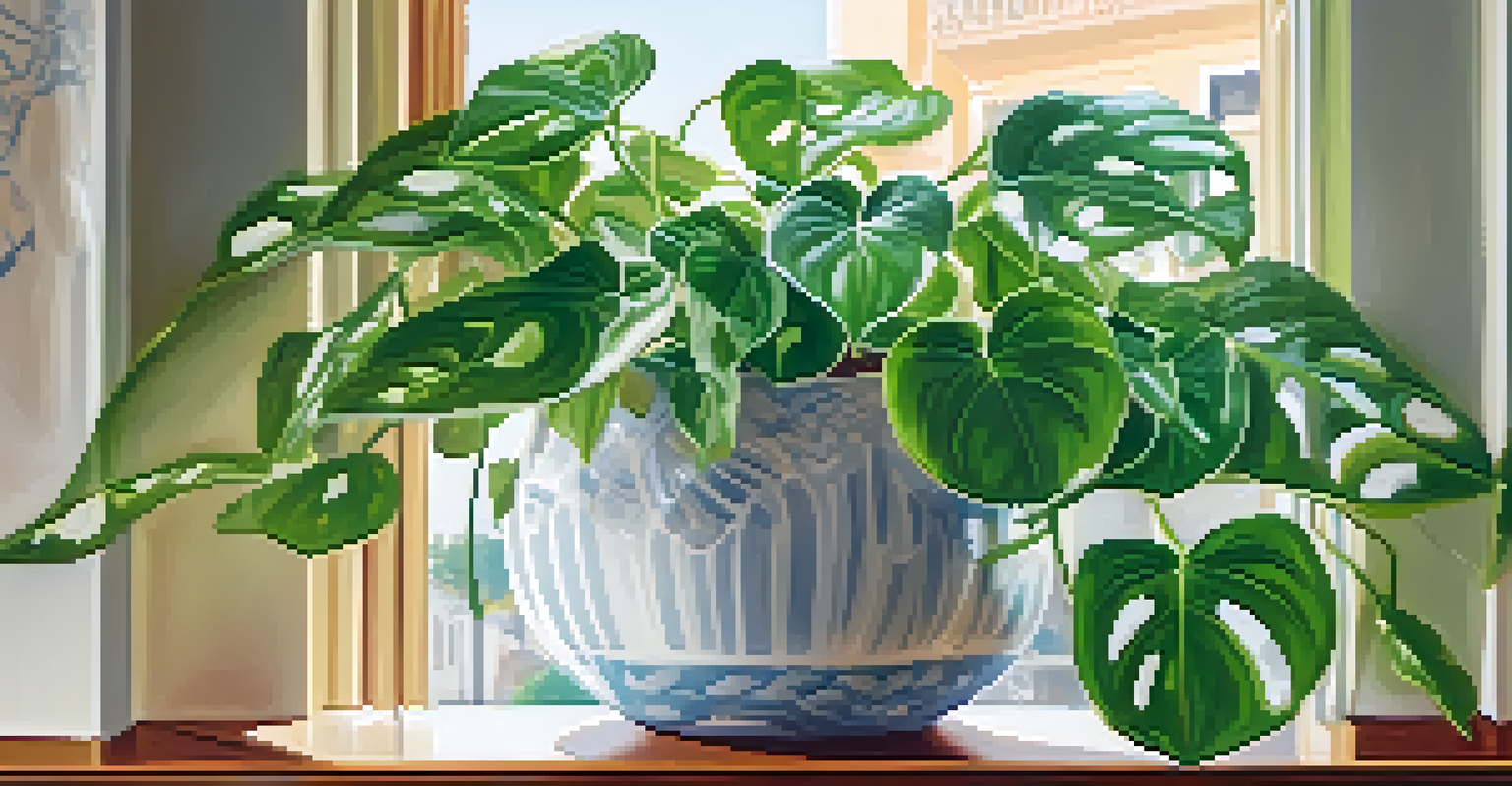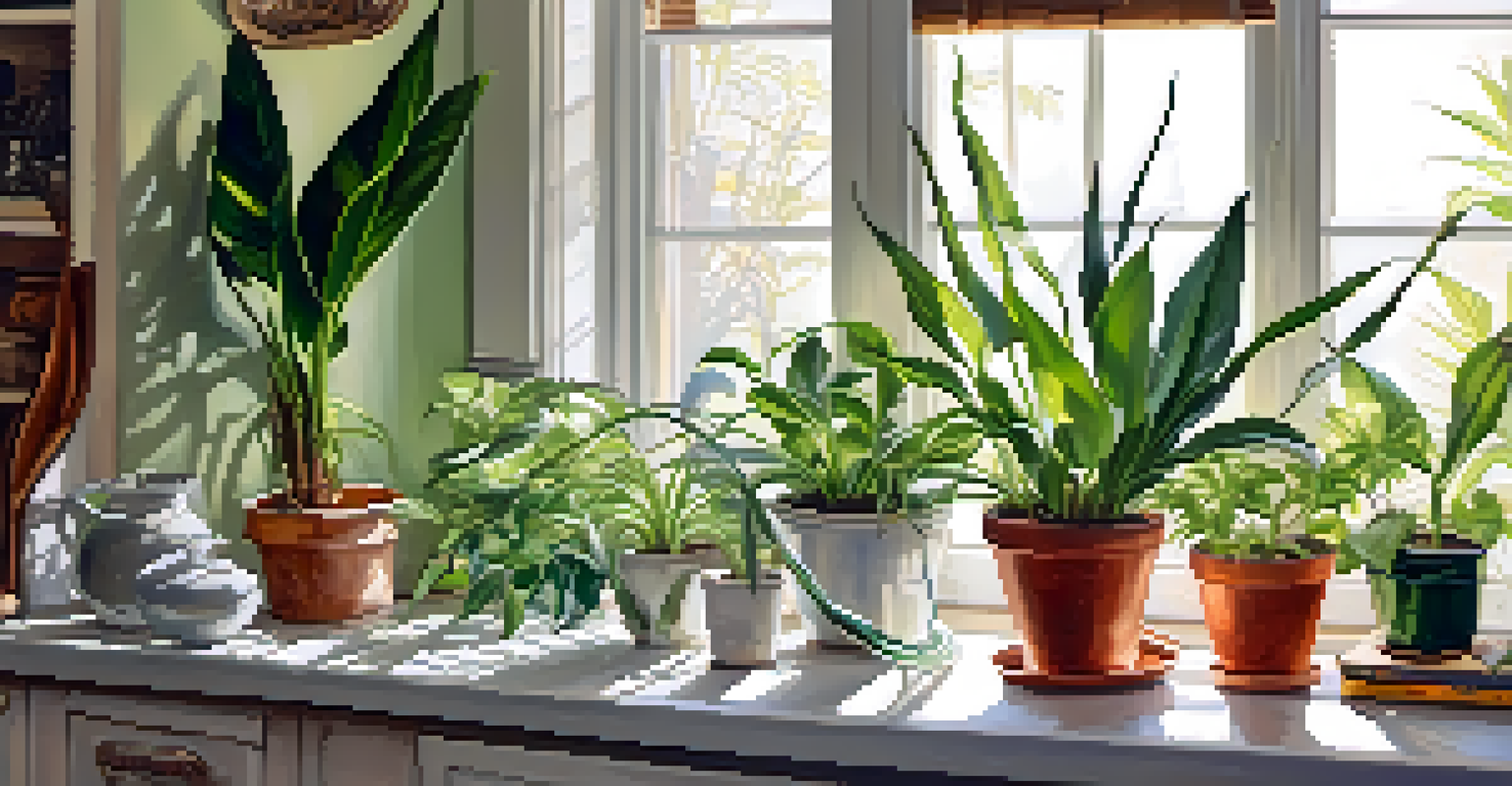Tropical Plants: Identifying Common Varieties for Beginners

Understanding Tropical Plants and Their Needs
Tropical plants are known for their vibrant colors and lush foliage, often associated with warm, humid climates. They thrive in environments that mimic their native habitats, requiring specific conditions like plenty of sunlight and moisture. Understanding these needs is crucial for beginners who want to successfully grow tropical varieties at home.
Plants are like people; they thrive when they are cared for and loved.
For instance, many tropical plants prefer well-draining soil and benefit from regular watering, but be cautious of overwatering, which can lead to root rot. Using a pot with drainage holes is a simple yet effective way to keep your plants happy. Additionally, consider using a humidity tray or misting your plants to replicate the moist air they crave.
By grasping the fundamental requirements of tropical plants, beginners can set themselves up for success. Whether it's a bright corner of your living room or a sunny balcony, creating the right environment is the first step in your tropical gardening journey.
Popular Tropical Plants for Beginners
Starting with popular varieties can ease the learning curve for new plant enthusiasts. Some beginner-friendly tropical plants include pothos, snake plants, and peace lilies, all known for their resilience and low maintenance needs. These plants not only add beauty to your space but also help purify the air.

Pothos, for example, is a trailing vine that thrives in various light conditions and can tolerate occasional neglect. Snake plants, with their striking upright leaves, are perfect for those who may forget to water regularly. Meanwhile, peace lilies showcase beautiful white blooms and can survive in lower light environments, making them versatile choices.
Tropical Plants Require Care
Understanding the specific needs of tropical plants, such as light, moisture, and soil conditions, is essential for successful growth.
Choosing these common varieties allows beginners to gain confidence in their plant care skills. As they become more comfortable, they can explore a wider range of tropical plants, expanding their indoor jungle with ease.
Caring for Your Tropical Plants: Key Tips
Caring for tropical plants involves a few simple yet effective practices to keep them thriving. Regular watering is vital, but it’s essential to check the soil's moisture level first. Stick your finger about an inch into the soil; if it feels dry, it’s time to water. This approach prevents both underwatering and overwatering, which can be detrimental to plant health.
The greatest gift of the garden is the restoration of the five senses.
Fertilizing your tropical plants during the growing season—typically spring and summer—can also promote lush growth. A balanced liquid fertilizer diluted to half-strength every month works wonders. Just remember to follow the manufacturer’s instructions to avoid over-fertilizing, which can harm the plant.
Lastly, keep an eye out for pests, like spider mites or aphids. Regularly inspecting your plants and wiping the leaves can help prevent infestations, ensuring your tropical garden remains vibrant and healthy.
Using Light to Enhance Growth in Tropical Plants
Understanding the light requirements of your tropical plants is crucial for their growth and overall health. Most tropical plants thrive in bright, indirect sunlight, but direct sunlight can scorch their leaves. A good rule of thumb is to place them near a window with filtered light or use sheer curtains to soften the intensity.
If natural light is limited in your home, consider using grow lights. These specialized lights can supplement natural sunlight and provide the right spectrum for plant growth. They are especially beneficial during the winter months or in rooms with minimal sunlight.
Beginner-Friendly Plant Options
Starting with resilient tropical plants like pothos, snake plants, and peace lilies can help new gardeners build confidence in their plant care skills.
By optimizing the light conditions for your tropical plants, you enhance their ability to photosynthesize, leading to more vigorous growth and vibrant foliage. It’s a simple yet impactful way to create a thriving indoor garden.
The Joy of Propagating Tropical Plants
One of the most rewarding aspects of caring for tropical plants is the ability to propagate them. Many common varieties can be easily propagated through cuttings, allowing you to expand your collection or share plants with friends. For example, pothos cuttings can root in water, making it a fun and simple way to grow new plants.
To propagate, simply take a healthy cutting with a few leaves and place it in water or directly in soil. In a few weeks, you’ll see roots developing, signaling that your new plant is ready to thrive on its own. This process not only saves money but also deepens your connection with your plants.
Moreover, propagating plants can be a wonderful way to learn more about their growth habits and care requirements. As you witness the life cycle of your tropical plants, you’ll gain confidence and knowledge that will serve you well in your gardening journey.
Common Challenges and Solutions for Beginners
Every plant parent faces challenges, especially when starting with tropical plants. Common issues include yellowing leaves, stunted growth, or pests. Identifying the root cause is the first step in resolving these problems, often requiring a bit of detective work.
For instance, yellowing leaves can indicate overwatering, underwatering, or a lack of nutrients. Adjusting your watering schedule or adding fertilizer can often remedy these issues. Additionally, ensuring proper drainage and selecting the right potting mix can create a healthier environment for your plants.
Troubleshoot Common Plant Issues
Identifying and addressing common challenges such as yellowing leaves or pests is key to maintaining the health of your tropical plants.
Don't be discouraged by these challenges; they are part of the learning process. With patience and observation, you’ll develop the skills to troubleshoot and care for your tropical plants effectively, turning potential setbacks into valuable lessons.
Creating a Tropical Oasis in Your Home
Once you’ve selected and cared for your tropical plants, it’s time to think about how to display them. Arranging your plants can transform your living space into a lush, tropical oasis. Consider grouping plants with similar light and watering needs together to create a harmonious display.
Using decorative pots and stands can further enhance the visual appeal of your plants. Mix different heights and textures to create an eye-catching arrangement. You could even incorporate shelves or plant hangers to showcase trailing varieties like pothos or ivy.

Creating a tropical oasis is not only about aesthetics; it also boosts your mood and enhances your living environment. Surrounded by greenery, you’ll find joy in nurturing your plants while enjoying the benefits of improved air quality and a more serene home atmosphere.